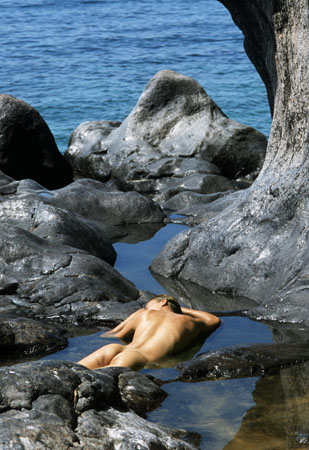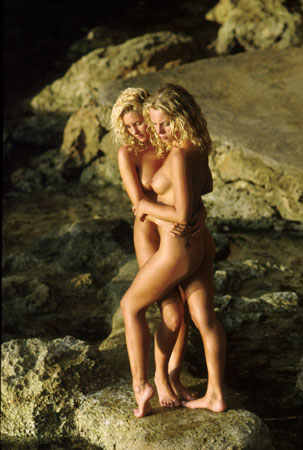Attitudes to partial or complete nudity vary widely from culture to culture, and even between communities within cultures. I have travelled in 110 countries and seven continents and rarely found social attitudes to be the same as those 200 miles down the road. It is therefore not surprising that exposure of the body is a particularly complicated issue when considered on a global scale. In Brazil, a woman who goes topless on Copacabana beach may have sand thrown in her face – she may regarded by some local people as a hussy. However she may wear a tanga, an almost invisible thong-style bikini bottom, without fear of sanction. Paradoxically, the same woman, presented in a similar fashion, might be arrested on some European beaches not for going topless but because the tanga might be regarded as obscene.
 However, despite international and regional variations in attitudes, there are undoubtedly a few universal truths. The nude is always erotic and photographers must develop their treatment of the subject with sensitivity if they wish to avoid potentially serious or uncomfortable problems. Local attitudes to both the shoot and the public usage of images must be respected, even when they seem culturally incomprehensible. Extensive geographical scope and consequent wider implications of public image usage must, where relevant, also be carefully considered. Every individual within a community espouses a slightly different version of local attitudes, so the closer photographers work to the generally accepted but poorly-defined boundaries of acceptability the more likely they are to encounter criticism. Prudently-worded and legally-binding model release forms must be signed for every nude shoot and for each image used in public. To do otherwise is nothing less than irresponsible. It is not even unusual for models to change their minds about the use of their naked images despite having signed model release forms. A typical situation arises when a young model acquires a husband or wife who finds previously taken images disagreeable. The couple then decide to make a legal challenge. This is arguably more prevalent in, but not exclusive to, the amateur world.
However, despite international and regional variations in attitudes, there are undoubtedly a few universal truths. The nude is always erotic and photographers must develop their treatment of the subject with sensitivity if they wish to avoid potentially serious or uncomfortable problems. Local attitudes to both the shoot and the public usage of images must be respected, even when they seem culturally incomprehensible. Extensive geographical scope and consequent wider implications of public image usage must, where relevant, also be carefully considered. Every individual within a community espouses a slightly different version of local attitudes, so the closer photographers work to the generally accepted but poorly-defined boundaries of acceptability the more likely they are to encounter criticism. Prudently-worded and legally-binding model release forms must be signed for every nude shoot and for each image used in public. To do otherwise is nothing less than irresponsible. It is not even unusual for models to change their minds about the use of their naked images despite having signed model release forms. A typical situation arises when a young model acquires a husband or wife who finds previously taken images disagreeable. The couple then decide to make a legal challenge. This is arguably more prevalent in, but not exclusive to, the amateur world.
Different attitudes and standards are also commonly applied to female and male models. The reasons for this are complex and again vary from culture to culture. However, in the western world the female nude is largely accepted and widely used or abused in advertising, the printed media and entertainment. The male nude is less well accepted and used mostly in more subtle and limited ways. This is not because censors and editors are male – many are female. It is principally because the female nude is more photogenic and also easier to use. The female form is more curvaceous and graceful and, when appropriately posed and lit, more photographically interesting. This is recognized by a large number of female photographers. The male nude can also be beautiful, as Michelangelo was well aware, but presents a photographer with more restricted scope and greater hazards.
 There are some simple physical facts from which there is no escape. The female genitals are essentially internal and consequently more concealed than the external male genitals. They are also less obvious in the context of revealing sexual intent – a key factor to which I shall return. In a similar but contra-indicative manner, female breasts are seen as more obvious and provocative than those of the male, so western culture is less tolerant of bare-chested women in public. The situation is of course different in other cultures. To attempt to apply the same standards of acceptability to female and male nudes is therefore naive. Societies have decided over the centuries, whether we like it or not, that the two are quite different. We can of course disagree, and even seek change, but work exposed to the public gaze will inevitably be judged by the current attitudes of society at large.
There are some simple physical facts from which there is no escape. The female genitals are essentially internal and consequently more concealed than the external male genitals. They are also less obvious in the context of revealing sexual intent – a key factor to which I shall return. In a similar but contra-indicative manner, female breasts are seen as more obvious and provocative than those of the male, so western culture is less tolerant of bare-chested women in public. The situation is of course different in other cultures. To attempt to apply the same standards of acceptability to female and male nudes is therefore naive. Societies have decided over the centuries, whether we like it or not, that the two are quite different. We can of course disagree, and even seek change, but work exposed to the public gaze will inevitably be judged by the current attitudes of society at large.
Children present a different but equally sensitive problem. Over the last couple of decades the western world has become obsessed with the protection of minors from abuse. The problem is recognized worldwide but the western emphasis, right or wrong, is neither found nor understood across much of the globe. I have taken wholesome pictures of naked children, both girls and boys, in many countries. I have never experienced any difficulty. However, in my home community, where I am known and trusted, similar activities would be impossible. I recently submitted an image of a naked four-year-old Asian boy to a female London publisher. She refused point blank to publish it principally because the image revealed his genitals, but was also concerned by the more difficult issue of consent. However the same publisher accepted without question a full-length image of four naked and sexually mature young women running directly towards my camera.
If a single critical issue can be identified in all of this, it is surely that of intent. What is the underlying and often undeclared purpose for which an image was created, and what message is the photographer trying to convey to the viewer? The two images in this article are likely to convey different quite messages to most people. Images of the nude rarely derive aesthetic value from a dependence upon exposure, titillation or shock. Those that exhibit credible artistic merit, and so avoid the broad disapproval of society in general, are more likely to be understated and restrained. Indeed the best images often work because of what they conceal rather than what they expose. A degree of modesty, and subtle and judicious use of shadows, can be more atmospheric than fully-lit revelation. The divide that separates beauty from banality, tastelessness and worse is perilously narrow. Consequently, a photographer’s work can all too easily enter or traverse the ill-defined grey area that separates the two. A chest thrust slightly too far forward, a leg positioned a little more provocatively, or a subtle change of facial expression can radically alter perceived intent and transform an artistic nude into something much less attractive.
Working with the nude, arguably the most difficult photographic genre, is particularly difficult for numerous reasons. This article addresses just one - the issue of acceptability. Other factors such as trust, privacy, political correctness, legality, release, interpersonal relationships and lighting can be just as contentious. Beware!






